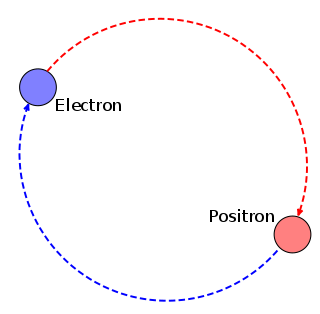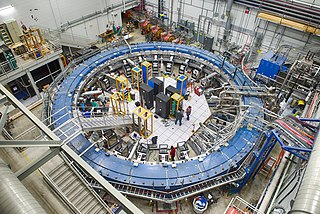
The Hall effect is the production of a potential difference across an electrical conductor that is transverse to an electric current in the conductor and to an applied magnetic field perpendicular to the current. It was discovered by Edwin Hall in 1879.

A muon is an elementary particle similar to the electron, with an electric charge of −1 e and a spin of 1/2, but with a much greater mass. It is classified as a lepton. As with other leptons, the muon is not thought to be composed of any simpler particles.

In particle physics, quantum electrodynamics (QED) is the relativistic quantum field theory of electrodynamics. In essence, it describes how light and matter interact and is the first theory where full agreement between quantum mechanics and special relativity is achieved. QED mathematically describes all phenomena involving electrically charged particles interacting by means of exchange of photons and represents the quantum counterpart of classical electromagnetism giving a complete account of matter and light interaction.

Positronium (Ps) is a system consisting of an electron and its anti-particle, a positron, bound together into an exotic atom, specifically an onium. Unlike hydrogen, the system has no protons. The system is unstable: the two particles annihilate each other to predominantly produce two or three gamma-rays, depending on the relative spin states. The energy levels of the two particles are similar to that of the hydrogen atom. However, because of the reduced mass, the frequencies of the spectral lines are less than half of those for the corresponding hydrogen lines.

The Standard Model of particle physics is the theory describing three of the four known fundamental forces in the universe and classifying all known elementary particles. It was developed in stages throughout the latter half of the 20th century, through the work of many scientists worldwide, with the current formulation being finalized in the mid-1970s upon experimental confirmation of the existence of quarks. Since then, proof of the top quark (1995), the tau neutrino (2000), and the Higgs boson (2012) have added further credence to the Standard Model. In addition, the Standard Model has predicted various properties of weak neutral currents and the W and Z bosons with great accuracy.

In particle physics, a lepton is an elementary particle of half-integer spin that does not undergo strong interactions. Two main classes of leptons exist: charged leptons, including the electron, muon, and tauon, and neutral leptons, better known as neutrinos. Charged leptons can combine with other particles to form various composite particles such as atoms and positronium, while neutrinos rarely interact with anything, and are consequently rarely observed. The best known of all leptons is the electron.
In theoretical physics, a chiral anomaly is the anomalous nonconservation of a chiral current. In everyday terms, it is equivalent to a sealed box that contained equal numbers of left and right-handed bolts, but when opened was found to have more left than right, or vice versa.
In physics, the gyromagnetic ratio of a particle or system is the ratio of its magnetic moment to its angular momentum, and it is often denoted by the symbol γ, gamma. Its SI unit is the radian per second per tesla (rad⋅s−1⋅T−1) or, equivalently, the coulomb per kilogram (C⋅kg−1).
In particle physics, lepton number is a conserved quantum number representing the difference between the number of leptons and the number of antileptons in an elementary particle reaction. Lepton number is an additive quantum number, so its sum is preserved in interactions. The lepton number is defined by
In atomic physics, the electron magnetic moment, or more specifically the electron magnetic dipole moment, is the magnetic moment of an electron resulting from its intrinsic properties of spin and electric charge. The value of the electron magnetic moment is −9.2847646917(29)×10−24 J⋅T−1. In units of the Bohr magneton (μB), it is −1.00115965218059(13) μB, a value that was measured with a relative accuracy of 1.3×10−13.
The electron electric dipole momentde is an intrinsic property of an electron such that the potential energy is linearly related to the strength of the electric field:

In quantum electrodynamics, Bhabha scattering is the electron-positron scattering process:
A g-factor is a dimensionless quantity that characterizes the magnetic moment and angular momentum of an atom, a particle or the nucleus. It is essentially a proportionality constant that relates the different observed magnetic moments μ of a particle to their angular momentum quantum numbers and a unit of magnetic moment, usually the Bohr magneton or nuclear magneton. Its value is proportional to the gyromagnetic ratio.
Quantum electrodynamics (QED), a relativistic quantum field theory of electrodynamics, is among the most stringently tested theories in physics. The most precise and specific tests of QED consist of measurements of the electromagnetic fine-structure constant, α, in various physical systems. Checking the consistency of such measurements tests the theory.
R is the ratio of the hadronic cross section to the muon cross section in electron–positron collisions:

The dark photon is a hypothetical hidden sector particle, proposed as a force carrier similar to the photon of electromagnetism but potentially connected to dark matter. In a minimal scenario, this new force can be introduced by extending the gauge group of the Standard Model of Particle Physics with a new abelian U(1) gauge symmetry. The corresponding new spin-1 gauge boson can then couple very weakly to electrically charged particles through kinetic mixing with the ordinary photon and could thus be detected. The dark photon can also interact with the Standard Model if some of the fermions are charged under the new abelian group. The possible charging arrangements are restricted by a number of consistency requirements such as anomaly cancellation and constraints coming from Yukawa matrices.

Muon g − 2 is a particle physics experiment at Fermilab to measure the anomalous magnetic dipole moment of a muon to a precision of 0.14 ppm, which is a sensitive test of the Standard Model. It might also provide evidence of the existence of new particles.

In theoretical physics, the dual photon is a hypothetical elementary particle that is a dual of the photon under electric–magnetic duality which is predicted by some theoretical models, including M-theory.
David William Hertzog is an American particle physicist, known for his research in precision muon physics.
The nucleon magnetic moments are the intrinsic magnetic dipole moments of the proton and neutron, symbols μp and μn. The nucleus of an atom comprises protons and neutrons, both nucleons that behave as small magnets. Their magnetic strengths are measured by their magnetic moments. The nucleons interact with normal matter through either the nuclear force or their magnetic moments, with the charged proton also interacting by the Coulomb force.































